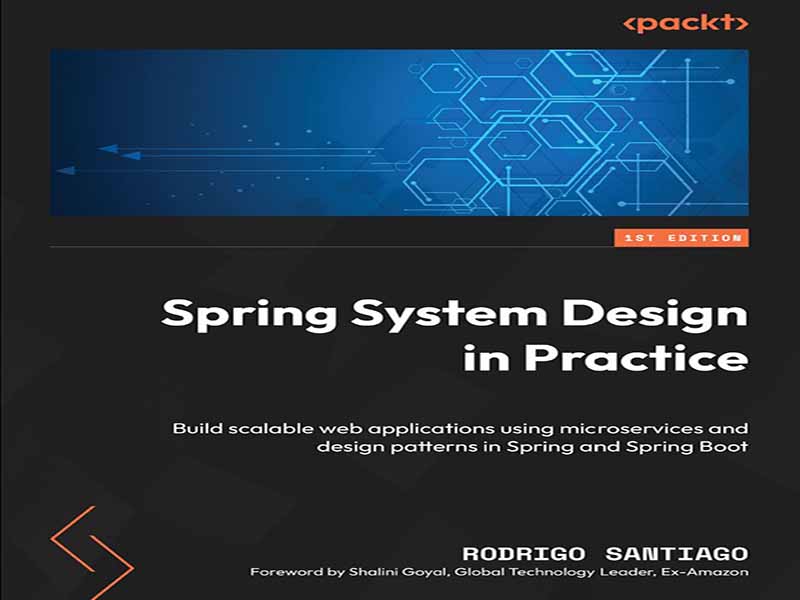- عنوان کتاب: Spring System Design in Practice, Build scalable web applications using microservices and design patterns in Spring and Spring Boot
- نویسنده: Rodrigo Santiago
- حوزه: برنامه نویسی جاوا
- سال انتشار: 2025
- تعداد صفحه: 452
- زبان اصلی: انگلیسی
- نوع فایل: pdf
- حجم فایل: 8.83 مگابایت
چه در حال برداشتن اولین قدمهای خود در دنیای اسپرینگ باشید و چه یک معمار سیستم باتجربه باشید که به دنبال اصلاح رویکرد خود به سرویسهای وب مقیاسپذیر است، این کتاب چیزی برای شما دارد. اگر در اسپرینگ تازهکار هستید، ممکن است از اکوسیستم وسیع آن احساس سردرگمی کنید. از کجا شروع میکنید؟ چگونه برنامه خود را ساختار میدهید؟ چگونه همه این اجزا با هم هماهنگ میشوند؟ ما آنجا بودهایم. به همین دلیل است که این کتاب شما را با اصول اولیه – از تشریح الزامات گرفته تا طراحی APIها، نوشتن سرویسها، ادغام پایگاههای داده و مدیریت امنیت – آشنا میکند. تا زمانی که این کتاب را تمام کنید، با اطمینان یک برنامه Spring کاملاً کاربردی و آماده تولید ساختهاید. برای معماران سیستم و توسعهدهندگان باتجربه، این کتاب یک رویکرد ساختاریافته برای طراحی سرویسهای مقیاسپذیر و انعطافپذیر ارائه میدهد. ما بهترین شیوهها را برای طراحی API، احراز هویت با کلیدهای نامتقارن، معماریهای مبتنی بر رویداد و تحمل خطا پوشش خواهیم داد. اگر میخواهید مطمئن شوید که برنامههای Spring شما میتوانند پیچیدگیهای دنیای واقعی را مدیریت کنند و در عین حال قابل نگهداری و کارآمد باقی بمانند، این کتاب به شما کمک میکند تا به آنجا برسید. این کتاب فرض میکند که شما تجربه قبلی با یک زبان برنامهنویسی شیگرا و درک اولیهای از نحوه نوشتن کد جاوا دارید. نیازی نیست که در فرآیندهای توسعه نرمافزار متخصص باشید – هدف ما ارائه یک چارچوب روشن است که به شما کمک میکند تا الزامات سطح بالا را دریافت کرده و آنها را به یک خانواده انعطافپذیر از خدمات که به طور موثر مقیاسپذیر هستند، تجزیه کنید. بنابراین، چه تازه کار باشید و چه در حال بهبود مهارت خود، بیایید شروع کنیم و چیزهای عالی را با هم بسازیم! فصل 1، الزامات محصول چیست؟، به بررسی چگونگی ثبت الزامات محصول به روشی ساختار یافته و دقیق میپردازد که پایه و اساس مشکلات و راهحلهای به خوبی تعریف شده را تعیین میکند. هر سیستم عالی با یک هدف به خوبی تعریف شده شروع میشود. شما یاد خواهید گرفت که چگونه نیازهای کلیدی کسب و کار را شناسایی کرده و آنها را به اهداف فنی تبدیل کنید که از همان ابتدا توسعه را هدایت میکنند. فصل 2، مرتبسازی الزامات پیچیده به ویژگیها، موارد استفاده و داستانها، پیچیدگی پروژههای نرمافزاری را که اغلب به عنوان یک شبکه درهمتنیده از انتظارات شروع میشوند، با تجزیه الزامات به ویژگیهای واضح، موارد استفاده و داستانهای کاربر، از هم باز میکند. این رویکرد ساختار یافته تضمین میکند که ما آنچه را که واقعاً مهم است، در حالی که فرآیند توسعه را قابل مدیریت و متمرکز نگه میداریم، ثبت میکنیم. فصل ۳، «تعریف دامنهها برای برنامه شما»، توضیح میدهد که چگونه قبل از نوشتن حتی یک خط کد، باید دامنه کسبوکار را درک کنیم. در این فصل، از یک تکنیک کلیدی طراحی مبتنی بر دامنه (DDD) برای ایجاد نمایشهای بصری از مفاهیم اصلی سیستم خود استفاده خواهیم کرد و اطمینان حاصل میکنیم که مدلهای ما با منطق کسبوکار دنیای واقعی همسو هستند. فصل ۴، «تعریف سرویسها برای دامنههای شما»، توضیح میدهد که چگونه الزامات عملکردی به ما میگویند که سیستم باید چه کاری انجام دهد، اما الزامات فنی نحوه عملکرد آن را تعریف میکنند. ما محدودیتها و انتظارات فنی حیاتی را در سمت فنی پوشش خواهیم داد و اطمینان حاصل میکنیم که سرویسهای ما برای خواستههای دنیای واقعی با ابزارهای مناسب ساخته شدهاند. فصل ۵، «نوشتن سرویسهای شما – معرفی APIهای REST با چارچوب Spring»، اصول اصلی APIهای RESTful را معرفی میکند و شما را در ایجاد اولین سرویس مبتنی بر Spring، همراه با کنترلرها، مدیریت درخواستها و پاسخها، راهنمایی میکند. اکنون که پایه و اساس قوی از فصلهای قبلی داریم، زمان شروع ساخت فرا رسیده است! فصل 6، تبدیل الزامات تجاری به APIهای Spring با طراحی خوب، به شما میآموزد که چگونه با تعریف رابطهای کاربری واضح، جداسازی پیادهسازیها و ادغام یکپارچه سرویسهای مختلف با یکدیگر، سرویسهای Spring سازگار بسازید. همچنین مفاهیم کلیدی در مورد چگونگی ارائه رابطها و پیادهسازیهای Spring برای اتصال بسیار کارآمد به سیستمهای خارجی را پوشش خواهیم داد. فصل 7، مدیریت دادهها و تکامل میکروسرویس شما، توضیح میدهد که چگونه دادهها نیروی حیاتی هر سیستمی هستند و نحوه مدیریت ما با آنها، انعطافپذیری سرویسهای ما را تعیین میکند. در این فصل، نحوه کار با پایگاههای داده رابطهای در Spring، نحوه نمونهسازی سریع سرویس شما و رویکردهای مختلف برای ایجاد کوئریهای سفارشی در مقابل اتصالات داده آماده که بازیابی یا ذخیره دادهها را آسانتر میکنند، بررسی خواهیم کرد. فصل 8، ایمنسازی سرویسها با Spring Security و OAuth 2.0، یک راهنمای عملی برای پیادهسازی احراز هویت و مجوز با استفاده از Spring Security و OAuth 2.0 ارائه میدهد و تضمین میکند که سرویسهای ما از دادههای حساس محافظت میکنند و در عین حال دسترسی یکپارچه به کاربر را فراهم میکنند. امنیت در برنامههای مدرن غیرقابل مذاکره است. فصل ۹، ارتباط با کارایی بالا و امن بین سرویسهای Spring، توضیح میدهد که چرا وقتی چندین سرویس نیاز به ارتباط دارند، عملکرد و امنیت به نگرانیهای اساسی تبدیل میشوند. ما به استراتژیهایی برای کارآمد، امن و مقیاسپذیر کردن ارتباط بین سرویسها خواهیم پرداخت و نحوه ایجاد سرویسهای ناهمزمان با WebFlux را پوشش خواهیم داد. فصل ۱۰، ساخت سیستمهای ناهمزمان و رویداد محور با پایگاههای داده NoSQL، معماری رویداد محور را معرفی میکند.
Whether you’re taking your first steps into the world of Spring or you’re an experienced system architect looking to refine your approach to scalable web services, this book has something for you. If you’re new to Spring, you might feel overwhelmed by its vast ecosystem. Where do you start? How do you structure your application? How do all these components fit together? We’ve been there. That’s why this book walks you through the fundamentals—from dissecting requirements to designing APIs, writing services, integrating databases, and handling security. By the time you finish, you’ll have built a fully functional, production-ready Spring application with confidence. For system architects and experienced developers, this book provides a structured approach to designing scalable, resilient services. We’ll cover best practices for API design, authentication with asymmetric keys, event-driven architectures, and fault tolerance. If you want to ensure your Spring applications can handle real-world complexity while staying maintainable and performant, this book will help you get there. This book assumes you have some prior experience with an object-oriented programming language and a basic understanding of how to write Java code. You don’t need to be an expert in software development processes—our goal is to provide a clear framework that will help you take high-level requirements and break them down into a resilient family of services that scale effectively. So, whether you’re just starting out or refining your craft, let’s dive in and build great things together! Chapter 1, What Are the Product Requirements?, explores how to capture product requirements in a structured, precise way that sets the foundation for well-defined problems and solutions. Every great system starts with a well-defined purpose. You’ll learn how to identify key business needs and translate them into technical goals that guide development from the very beginning. Chapter 2, Sorting Complex Requirements into Features, Use Cases, and Stories, untangles the complexity of software projects often starting as a tangled web of expectations by breaking down requirements into clear features, use cases, and user stories. This structured approach ensures that we capture what truly matters while keeping the development process manageable and focused. Chapter 3, LayinDefining Domains for Your Application, explains how, before we write a single line of code, we need to understand the business domain. In this chapter, we’ll use a key domain-driven design (DDD) technique to create visual representations of our system’s core concepts, ensuring that our models align with real-world business logic. Chapter 4, Defining Services for Your Domains, explains how functional requirements tell us what the system must do, but technical requirements define how it should operate. We’ll cover the crucial technical constraints and expectations on the technical side, ensuring that our services are built for real-world demands with the right tools in place. Chapter 5, Writing Your Services – Introducing REST APIs with the Spring Framework, introduces the core principles of RESTful APIs and walks you through creating your first Spring-powered service, complete with controllers, request handling, and responses. Now that we have a strong foundation from the previous chapters, it’s time to start building! Chapter 6, Translating Business Requirements into Well-Designed Spring APIs, teaches you how to build adaptable Spring services by defining clear interfaces, decoupling implementations, and seamlessly integrating different services with each other. We’ll also cover key concepts of how Spring provides interfaces and implementations for connecting to external systems very efficiently. Chapter 7, Handling Data and Evolving Your Microservice, explains how data is the lifeblood of any system, and how we handle it determines the flexibility of our services. In this chapter, we’ll explore how to work with relational databases in Spring, how to prototype your service very quickly, and what the different approaches for creating custom queries versus out-of-the-box data connections are that make it easier to retrieve or save data. Chapter 8, Securing Services with Spring Security and OAuth 2.0, provides a hands-on guide to implementing authentication and authorization using Spring Security and OAuth 2.0, ensuring that our services protect sensitive data while providing seamless user access. Security is non-negotiable in modern applications. Chapter 9, High-Performance and Secure Communication Between Spring Services, explains why when multiple services need to communicate, performance and security become critical concerns. We’ll dive into strategies for making inter-service communication efficient, secure, and scalable, covering how to create asynchronous services with WebFlux. Chapter 10, Building Asynchronous, Event-Driven Systems with NoSQL Databases, introduces eventdriven architectures, showing how to decouple services using messaging systems and NoSQL databases to build scalable, reactive applications, as not all interactions need to happen in real time. Chapter 11, Launching Your Self-Organizing Microservice Cloud, explores how to launch a cloud-native Spring application, leveraging service discovery, API gateways, remote configurations, and other critical features that make your services connect to each other smoothly. Chapter 12, Optimizing Your Services, focuses on critical performance tuning, caching, handling failures gracefully, and improving resilience. From circuit breakers to concurrency solutions and distributed transaction consistency checks, we’ll ensure our services thrive under real-world conditions.
این کتاب را میتوانید از لینک زیر بصورت رایگان دانلود کنید:
Download: Spring System Design in Practice




































نظرات کاربران